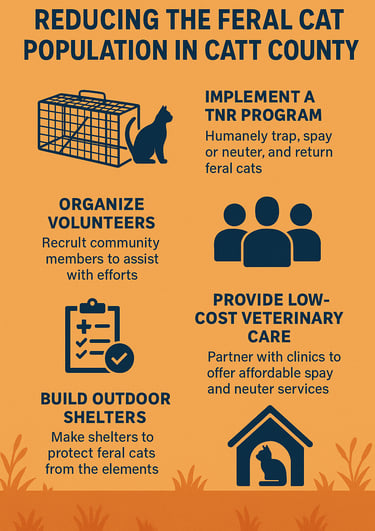Understanding the Feral Cat Problem
Feral cats are not simply strays or lost pets; they are usually the offspring of unowned, outdoor cats and are not socialized to humans. These cats often live in hidden colonies behind buildings, parks, or rural properties. Without intervention, a pair of unneutered cats can produce hundreds of offspring over their lifetime, quickly escalating the number of cats living outdoors.
Many of these cats suffer from common health issues due to malnutrition, disease, and injury. As they multiply, they strain local shelters, pose a nuisance to residents, and threaten local wildlife, especially birds and small mammals.
What is a TNR Program and Why It Works
The Trap-Neuter-Return (TNR) program is the most effective and humane method to control feral cat populations. This approach involves:
Trapping feral cats in a safe and non-harmful way.
Neutering or spaying them at a veterinary clinic.
Returning them to their original location, where they can live out their lives without reproducing.
Neutered cats are less likely to fight, roam, or spread disease. They also become better neighbors, reducing the disturbances often associated with feral colonies.
In Catt County, establishing or expanding a local TNR initiative could drastically reduce the number of feral cats over time while improving community relations and cat welfare.
How to Start a TNR Effort in Catt County
1. Identify Colonies
Begin by surveying your neighborhood or town for areas where feral cats are known to live. Talk with residents and observe potential hotspots such as alleyways, abandoned buildings, and barns.
2. Organize Volunteers
No one can tackle a TNR project alone. Recruit local animal lovers, vet techs, and community groups willing to help trap, transport, feed, and monitor the cats. Platforms like social media or community boards can help connect volunteers.
3. Work With Local Vets
Secure partnerships with local vets or clinics that offer low-cost veterinary care for spay and neuter procedures. Catt County should support or partner with mobile veterinary services or subsidized clinics to make neutering affordable.
4. Educate the Community
A successful TNR program requires community support. Educate your neighbors about the benefits of humane stray cat control. Let them know that the cats will return healthier and unable to reproduce.
5. Register with a Feral Cat Rescue
There are several organizations in New York that focus on feral cat rescue. Partnering with them can provide valuable resources, training, and sometimes even grant funding to support your local efforts.
Reducing the Feral Cat Population in Catt County
Feral cats are a growing concern across the United States, and Cattaraugus County (Catt County) is no exception. These free-roaming cats often live in colonies, reproduce rapidly, and face numerous health challenges. While they are a natural part of the ecosystem, unregulated populations can pose risks to public health, wildlife, and the cats themselves. Fortunately, with proactive strategies such as Trap-Neuter-Return (TNR) programs and increased public awareness, we can humanely reduce the feral cat population in Catt County.


The Role of Local Authorities
While much of the groundwork is grassroots, Cattaraugus County officials can play a vital role by:
Supporting local ordinances that permit TNR.
Providing funding or grants for community cat spay and neuter services.
Offering municipal property for colony care (feeding stations, shelters).
Educating residents on responsible pet ownership and the importance of neutering.
Low-Cost Veterinary Care Options
For a TNR program to be accessible, low-cost veterinary care is crucial. Residents of Catt County can reach out to:
Nearby spay/neuter clinics in Western New York.
Animal welfare organizations such as the Humane Society.
Mobile veterinary units offering community services.
These resources can reduce the financial burden on volunteers and increase the number of cats sterilized.
Building and Managing Outdoor Cat Shelters
Once neutered, cats should be returned to their territory. To ensure their health and safety, especially during the harsh Cattaraugus winters, volunteers can build simple insulated shelters. These can be made using plastic bins, straw, and weatherproof materials.
Feeders and water stations should also be maintained regularly. Monitoring the colony ensures that any new arrivals can be promptly trapped and neutered.
Public Involvement is Key
Everyone in the community can contribute to reducing the feral cat population:
Adopt a feral cat if they are friendly or young enough to be socialized.
Sponsor a TNR procedure.
Report sightings of large colonies to local rescue groups.
Avoid abandoning unwanted pets outdoors.
By working together, Catt County residents can make a meaningful difference.
Tracking Progress and Measuring Success
To assess the effectiveness of a TNR program, volunteers should keep records of:
The number of cats trapped, neutered, and returned.
Health conditions observed.
Incidents of new litters.
Community complaints before and after TNR efforts.
Over time, colonies will shrink naturally, and the quality of life for remaining cats will improve.
Final Thoughts
Reducing the feral cat population in Catt County is not just an animal welfare issue—it’s a community responsibility. By implementing a TNR program, promoting cat spay and neuter services, supporting feral cat rescue, and increasing access to low-cost veterinary care, we can create a humane and sustainable solution to an escalating problem.
Whether you're a resident concerned about your neighborhood, a cat lover, or a policymaker in Cattaraugus County, there is a role for you in helping the community cat population live healthier, safer lives.
Together, we can make Catt County a model for humane stray cat control—one colony at a time.
CATT COUNTY CAT NIPPERS

"I can't say enough good things about Catt County Cat Nippers. They helped a stray mother cat and her kittens in my neighborhood when no one else would. The volunteers were so kind and professional. Our community is better because of them."
Emily R., Local Resident

"Thanks to this amazing group, I found my best friend — a rescue cat named Oliver. The adoption process was smooth, and they really care about matching cats with the right homes. You can tell they love what they do."
Jason L., Cat Adopter


★★★★★
★★★★★
Subscribe to our website
Contact us :
Quick links :
Contact Us
© 2025 CATT COUNTY CAT NIPPERS All rights reserved.

